AUCTORES
Globalize your Research
Research Article | DOI: https://doi.org/10.31579/2692-9759/103
Departement of Cardiology, CHU of TLEMCEN, Algeria.
*Corresponding Author: F. Moussaoui, Departement of Cardiology, CHU of TLEMCEN, Algeria.
Citation: F. Moussaoui, R. Bali-Tabet, A. Meziane Tani, (2023), Epidemiological Profile of Myocardial Infarction with Non-Significant Stenosis of Coronary Arteries (MINOCA), Cardiology Research and Reports. 5(5); DOI:10.31579/2692-9759/103
Copyright: © 2023, F. Moussaoui. This is an open-access article distributed under the terms of the Creative Commons Attribution License, which permits unrestricted use, distribution, and reproduction in any medium, provided the original author and source are credited.
Received: 15 September 2023 | Accepted: 15 September 2023 | Published: 13 October 2023
Keywords: smokers; stressed; cardiac risk factors; drug addicts
Background:
Myocardial infarction with non-obstructive coronary arteries (MINOCA) remains a puzzling clinical entity characterized by clinical evidence of myocardial infarction (MI) with normal or near-normal coronary arteries on angiography (stenosis <50 %).
This pathology is poorly understood, several studies are underway for a better understanding of this disease. The aim of our work was to review the literature and assess the epidemiology, clinical features, prognosis and etiologies of MINOCA.
Methods
Descriptive, prospective study, spread over a period of 36 months from January 2018 to December 2020 involving a total number of 585 patients undergoing coronary angiography at the cardiology department of CHU Tlemcen, for a reason for acute myocardial ischemia.
We defined the patients as having acute myocardial ischemia with obstructive coronary artery disease (MI-CAD) if there was revascularization or plaque ≥ 50% and as having MINOCA if there was <50% obstruction or a mechanism without plaque. Patients who received thrombolytics before angiography were excluded.
We studied the epidemiological, clinical and prognostic profile of the MINOCA population then compared them to patients with obstructive coronary artery disease and finally we established an etiological analysis of the MINOCA population.
Results
The number of MINOCA cases in our sample of 585 AMI patients was 10.25% vs. 525 (89.74%) cases of AMI-CO, it was more common in men (78.3% vs. 21, 7%; odds ratio at 3.61) and in the youngest patients.
MINOCA patients were more likely to be without traditional cardiac risk factors (7.9% vs. 2.1%; P <0.001) but more predisposed to non-traditional risk factors than AMI-CO patients (3.7% against 1.8%; P = 0.026). Smoking is the only traditional risk factor frequent in the MINOCA population versus MI-CAD (P at 0.001).
Depression, stress, drug addiction, DVT history and autoimmune disease history are more frequent in the MINOCA population versus MI-CAD (P <0.05) STEMI are more found in the MINOCA population versus MI-CAD (P = 0.000)
In terms of prognosis, the MINOCA population had a better prognosis: less risk of recurrence than the MI-CAD population 6.7% versus 10.45% (P = 0.03) also less mortality 0% versus 4.6%
(P = 0.007).
Conclusion
The patients with MINOCA were more men, smokers, depressed, stressed, drug addicts with hypercoagulable states compared to patients with obstructive coronary artery disease (MI- CAD) however they had a better quality of life and a good prognosis.
The term "acute myocardial infarction" (AMI), which is used to describe a heart attack. When there are signs of heart muscle injury and necrosis in a context consistent with myocardial ischemia, the diagnosis of AMI is made [1-4]. There are two main categories of AMI: STEMI and non-STEMI. STEMI is used to describe patients with persistent chest pain and ST-segment elevation, while non-STEMI refers to patients without ST-segment elevation. AMI can also be classified into different types based on the cause and prognosis. One such type is "myocardial infarction with non-obstructive coronary arteries" (MINOCA), which occurs in the absence of significant coronary stenosis. This type of AMI was first described over 75 years ago and has been confirmed in several large studies, with up to 14% of AMI cases being MINOCA [5-8]. This type of AMI represents a diagnostic and therapeutic challenge, as many patients are discharged without a clear explanation for their symptoms [9-12].
Epidemiology
The prevalence of MINOCA (Myocardial Infarction with Non-Obstructive Coronary Arteries) in patients with MI (Myocardial Infarction) ranges from 1-15
This is a descriptive, single-center, prospective, observational study conducted in the cardiology department of CHU Tlemcen over a period of 36 months from January 1, 2018 to December 31, 2020. A questionnaire was completed for each patient. The variables studied
were collected from pre-coronary angiography forms and medical records of the patients using a data collection. The follow-up of these patients was performed through physical exams and telephone conversations.
Statistical analysis
Data analysis was performed using the SPSS software
Study Results
THE FREQUENCY of MINOCA: figure 1
60 ases of MINOCA out of 585 cases of AMI >>>> So 10.25%
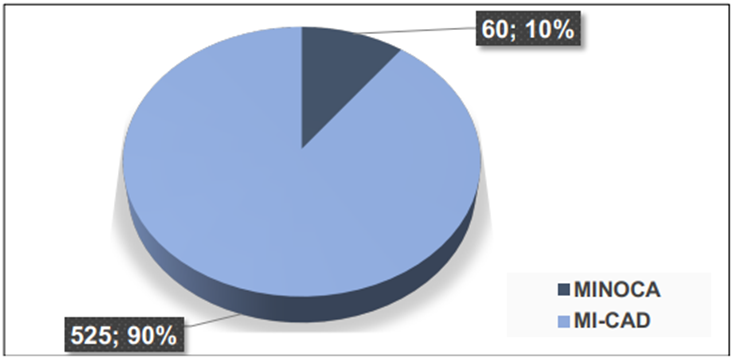
Figure 1
Comparative analytical study of the MINOCA population with the acute myocardial ischemia with obstructive coronary arteries (mi-cad) population:
Gender distribution MINOCA versus MI-CAD: figure 2

Figure 2
No significant difference was found between the MINOCA and MI-CAD population based on gender (P=0.297).
Breakdown by mean age MINOCA versus MI-CAD: figure 3
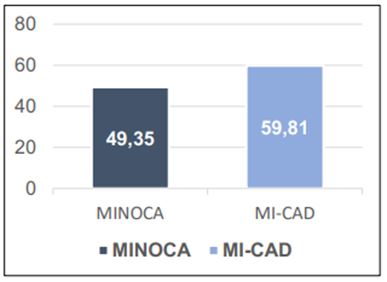
Figure 3
No significant difference was found between the MINOCA and MI-CAD populations based on gender (P=0.297). The MINOCA population was found to be younger compared to the MI- CAD population, with an average age of 49.35 years for MINOCA and 59.81 years for MI- CAD (P = 0.0001). Comparison according to the frequency of conventional risk factors between the MINOCA and MI-CAD population: figure 4
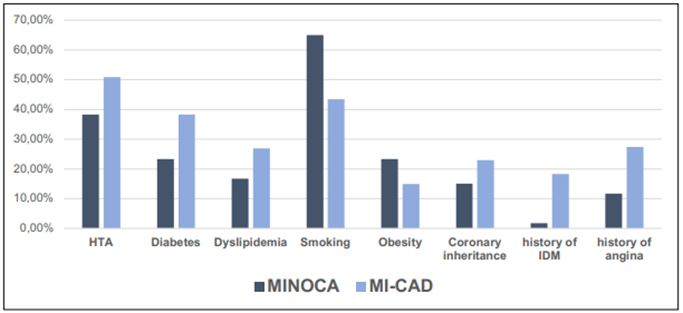
Figure 4
The study found that hypertension was more commonly found in the MI-CAD population compared to the MINOCA population, but the difference was not significant (P=0.066). Diabetes was more frequently found in the MI-CAD population compared to the MINOCA population, and the difference was significant (P=0.023). Dyslipidemia was more commonly found in the MI-CAD population compared to the MINOCA population, but the difference was not significant (P=0.087). Smoking was more frequent in the MINOCA population compared to the MI-CAD population, and the difference was significant (P=0.001). Obesity was more frequently found in the MINOCA population compared to the MI-CAD population, but the difference was not significant (P=0.088). Coronary hereditary was more commonly found in the MI-CAD population compared to the MINOCA population, but the difference was not significant (P=0.164). History of MI was more frequent in the MI-CAD population compared to the MINOCA population, and the difference was significant (P=0.001). History of angina was also more frequent in the MI-CAD population compared to the MINOCA population, and the difference was significant (P=0.008). The study concluded that diabetes, history of MI, and history of angina are more common in the MI-CAD population compared to MINOCA, but smoking is the only risk factor that is more common in the MINOCA population compared to MI-CAD.
Comparison according to the frequency of unconventional risk factors between the MINOCA and MI-CAD population: figure 5
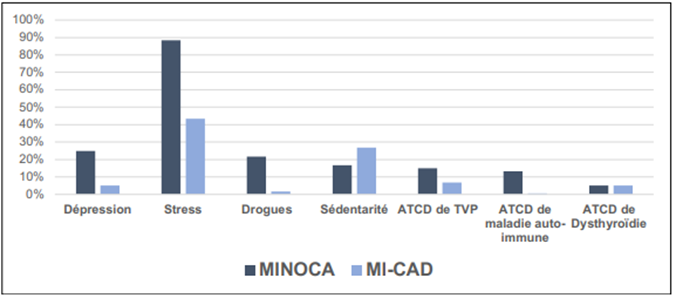
Figure 5
Depression, stress, and drug use were found to be more common in the MINOCA population compared to the MI-CAD population with a significant difference (P=0.000). A history of deep vein thrombosis was also found to be more common in the MINOCA population compared to the MI-CAD population with a significant difference (P=0.025). A history of autoimmune disease was also found to be more common in the MINOCA population compared to the MI-CAD population with a significant difference (P=0.000). However, there was no significant difference found in the history of dysthymia between the two populations (P=0.962). A sedentary lifestyle was found to be more common in the MI-CAD population compared to the MINOCA population with a non-significant difference (P=0.088).
The distribution according to the indication of the urgent coronary angiography in MINOCA versus MI-CAD: figure 6
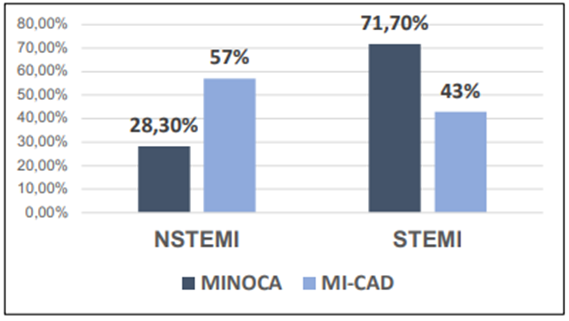
Figure 6
The NSTEMI are more represented in the MI-CAD population versus MINOCA with a significant difference P=0.000, while STEMI are more commonly found in the MINOCA population versus MI-CAD also with a significant difference P=0.000.
Distribution Based on Prognostic Factors MINOCA vs. MI-CAD
Recurrence: figure 7
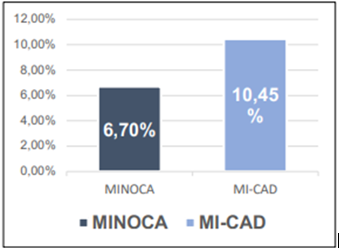
Figure 7
The MINOCA population has a lower risk of recurrence than the MI-CAD population, 6.7% versus 10.45% with a significant difference, P=0.03. The return-to-work MINOCA versus MI-CAD: figure 8
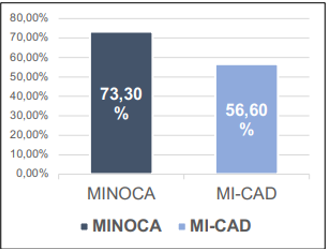
Figure 8
73.3% of MINOCA patients have returned to work, compared to only 56.6% of MI-CAD patients who have returned to work, with a significant difference, P=0.013.
mortality
The mortality: figure 9

Figure 9
The mortality rate in MI-CAD patients is 4.6% versus 0% in MINOCA patients with a significant difference, P=0.007.
Etiological Study:
An etiological evaluation was performed on 52 patients through a cardiac MRI and a thrombophilia evaluation on 40 patients.
Results: figure 10
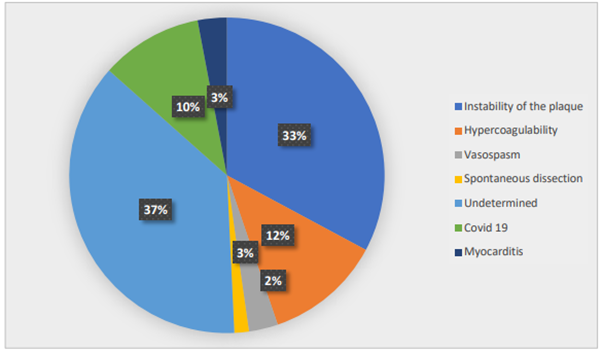
Figure 10
In our study, we aimed to compare the characteristics of MINOCA (Myocardial Infarction with Non-Obstructive Coronary Arteries) and MI-CAD (Myocardial Infarction with Obstructive Coronary Arteries) patients and identify any differences between the two groups.
Demographic Data:
In our study, we found that the mean age of MINOCA patients was 57.36 ± 10.26 years, while the mean age of MI-CAD patients was 55.17 ± 9.16 years, with no significant difference between the two groups (P = 0.123).
Traditional Risk Factors:
A systematic review by Pasupathy S et al, including the VIRGO study and other studies, showed that MINOCA patients have a lower prevalence of dyslipidemia compared to their SCA counterparts with obstructive coronary artery disease [10,11]. Other traditional coronary artery disease risk factors, such as hypertension, diabetes, smoking, and a family history of myocardial infarction, are less frequent in MINOCA patients [11].
Non-Conventional Risk Factors:
In our study, we found that depression, stress, drug use, previous DVT and autoimmune disease history were more frequent in the MINOCA population compared to MI-CAD, with a significant difference, but there was no significant difference between the two populations for other factors (sedentary lifestyle and hypothyroidism history).
Previous studies have shown the same results: The VIRGO study showed that MINOCA patients had fewer traditional cardiac risk factors but more often had risk factors such as previous drug use, hypercoagulability syndrome, venous thromboembolism and autoimmune diseases [11]. Daniel M et al, reported in a study that anxiety and depression were also frequent in MINOCA patients compared to IMA patients with obstructive coronary artery disease [20,21].
Clinical Presentation:
In our study, we found that NSTEMI (Non-ST Segment Elevation Myocardial Infarction) was more represented in the MI-CAD population compared to MINOCA, with a significant difference (P = 0.000), while STEMI (ST Segment Elevation Myocardial Infarction) was more found in the MINOCA population compared to MI-CAD, also with a significant difference (P = 0.000). However, Pasupathy S et al reported in a systematic review that STEMI and NSTEMI had similar ratios in patients [10].
Prognostic Factors
Recurrence:
In our work, we found a 12-month recurrence rate for the MINOCA population of 6.7%, significantly lower compared to the MI-CAD population of 10.45% with a significant difference P=0.03.
Bainey and al. studied the 1-year composite endpoint of death and/or reinfarction rate in MINOCA patients with angiography without coronary obstruction which were significantly lower than in MINOCA patients presenting stenosis <50 xss=removed>
Mortality:
In our work, we found a 12-month mortality rate for the MINOCA population of 0%, significantly lower compared to the MI-CAD population which was 4.6%, a non-significant difference P=0.007.
Safdar et al. reported similar results: 1 and 12-month mortality of MINOCA and IDM with obstructive coronaropathy [1 month: 1.1% and 1.7% (p = 0.43); 12 months: 0.6% and 2.3% (p = 0.68), respectively] were found, while Pasupathy et al. reported that mortality rates were significantly lower in the MINOCA group compared to IDM with obstructive coronaropathy [in-hospital: 1.1% and 3.2% (p = 0.001); 12-month 3.5% and 6.7% (p = 0.003), respectively].
Etiologies:
In our work, we found ischemic embolic and plaque instability in 33% (20 patients), hypercoagulability in 10% (6 patients), vasospastic in 03% (02 patients), myocarditis in 03% (02 patients), spontaneous dissection in 02% (01 patients), concomitant Covid-19 infection in 12% (7 patients) while we found no etiologies in 37% (22 patients).
We limited ourselves to these results as it was not our main objective of the study and there were several difficulties, including:
Difficult access to some complementary tests such as cardiac MRI and thrombophilia tests. Non-performance of provocation tests for patients (patient refusal)
Unavailability of coronary imaging exams such as IVUS and OCT in our catheterization center.
In the literature, the VIRGO11 study reported a rate of 75% of undetermined etiologies, 20% of spontaneous coronary dissection, 4% of coronary spasm, and 1% of embolization, this also confirms that the etiological evaluation of MINOCA is not easy and remains obscure in the majority of cases.
MINOCA is a common clinical entity among patients with AMI and encompasses numerous etiologies that can be difficult to detect.
The number of MINOCA cases in our sample of 585 AMI patients was 10.25% compared to 89.74% of obstructive coronary artery disease. It was more frequent among men and younger patients. MINOCA patients were more likely to be without traditional cardiac risk factors (7.9% compared to 2.1%; P <0 P=0.026); P=0.001).>
Depression, stress, drug use, a history of DVT, and a history of autoimmune disease were more frequent in the MINOCA population versus AMI-OCD with a significant difference. These patients were more likely to present as STEMI (P=0.000).
The MINOCA population had a better prognosis:
The majority of MINOCA patients had a good quality of life compared to AMI-OCD patients with a significant difference.
MINOCA patients had a lower risk of recurrence than the AMI-OCD population 6.7% versus 10.45% with a significant difference (P=0.03).
73.3% of MINOCA patients returned to work, while only 56.6% of AMI-OCD patients did so with a significant difference (P=0.013).
The 12-month mortality rate for the MINOCA population was 0%, significantly lower than the AMI-OCD population, which was around 4.6% (P=0.007, not significant).
The mechanisms of MINOCA in our cohort were varied: ischemic embolic etiology and plaque instability accounted for 33% (20 patients), hypercoagulability in 10% (6 patients),
vasospasm in 3% (2 patients), myocarditis in 3% (2 patients), spontaneous dissection etiology in 2% (1 patient), concurrent COVID-19 infection in 12% (7 patients), and etiologies were not found in 37% (22 patients).
This observation raises some research questions that could improve our understanding of this entity and its characteristics compared to obstructive coronary artery disease and the determination of optimal treatment based on specific cause in the future.
Quickly address acute myocardial ischemia, especially STEMI and NSTEMI, by widespread use of interventional therapy and rapid access to coronary angiography, which significantly improves the overall prognosis of coronary disease through early revascularization.
Familiarize all cardiologists with the term MINOCA, which represents a significant portion of acute myocardial ischemia’s.
Fight against cardiovascular risk factors in general and especially against smoking, drug abuse, and consumption of all types of drugs, which are important causes of this pathology.
Detect and properly manage patients with depression, anxiety, and stress through general medical consultations and refer them to psychologists and psychiatrists for follow-up; these are important risk factors for MINOCA.
Properly manage hypercoagulation states, especially a history of deep vein thrombosis, and search for a thrombophilia that constitutes a risk factor for MINOCA.
Detect and manage autoimmune diseases, which are also a risk factor for MINOCA.
Facilitate and generalize access to cardiac MRI in patients with MINOCA: ensure that its cost is covered by the social security system, especially for this entity.
Facilitate the acquisition and equipment of cardiac catheterization rooms with new coronary imaging tools, especially IVUS and OCT.